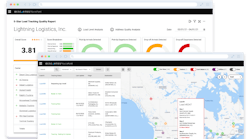Garmin has released its first Android-based navigation devices, combining the simplicity of Garmin navigation and the customization options of Android technology.
The new fleet 660 and fleet 670 navigators allow service providers to “introduce customized applications and value-added services that meet the unique requirements of their customers,” Garmin said. The devices also connect to and control a wide range of external devices over WiFi, Bluetooth, or serial cable.
“The fleet 660 and 670 are our first fleet products that combine trusted Garmin navigation and hardware with the flexibility of Android,” said Chad Sallman, senior business development manager for commercial solutions at Garmin. “These new devices remove many of the hurdles fleet service providers face today, making it easier than ever to develop customized solutions for both medium and large, enterprise class customers.”
Users can easily integrate existing applications from their partners for signature captures, work orders, or inspection reports, for example. The easy-to-use interface is fully customizable and applications and widgets can be added onto the device home screen.
The fleet 660 and 670 hardware is optimized for in-cab use with a dust-proof design, high-sensitivity GPS, extra loud speaker, and a sunlight readable, 6-in. capacitive touchscreen that makes it easy to see driving-related information at a glance.
They come with a powered magnetic mount for quick and easy removal between vehicles. Through Bluetooth and WiFi the devices wirelessly connect to a black box data transponder or other sensors and peripherals, such as a wireless printer or card reader.
The fleet 660 and 670 include the latest navigation technology from Garmin, such as Garmin Real Directions, voice activated navigation, Active Lane Guidance with voice prompts as well as free lifetime traffic and maps. Both devices also feature an integrated gyroscope to record and analyze driving behavior and support Near Field Communication (NFC) for driver and vehicle identification and data synchronization.
The fleet 660 is designed for local-service fleets while the fleet 670 is for commercial long-haul trucking fleets with its trucking-specific functions, such as route calculation based on truck attributes, trucking points of interest, hours-of-service logging, and International Fuel Tax Agreement Documentation.


